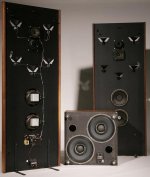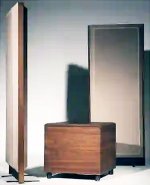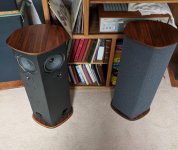You are right, usually i type like this Early Reflection then use ER to ease understanding, but i am lazy today.
Sorry, it is not my invention. I have written many posts recently regarding early reflections though 😀 It is as common shortcut as DI, people just don't talk about it too much I think. I find English quite hard and slow to express on, so tried using the shortcuts. Carry on.
He he Tmuikku i used a lot ER too for the last 10 years... sometimes i think i'm kind of obsessed. 😀
And i don't claim a patent on it but like you i find repetitive and time consuming to type it in plain words so... one time in plain word then ER! 😉
As i was looking for something related to phase/group delay last night ( blame Camplo! 😀 ) i reloaded a document about it from Jean Michel Le Cleac'h and found some example about real instruments radiation behavior ( and there is other things related to the thread subject too until page 27 imho) so it may be of interest to take a look at page 5/6/7 to have a more in depth explanation/ exemple of some instruments behavior and why i questioned the 'omni' radiation pattern ( there is of course many other interesting things too but it is in french... that said with google translator it could be understandable):
http://www.melaudia.net/zdoc/distorsion_de_phase.pdf
Ps: try to load directly the pdf if it doesn't open when clicking on the link, it is present but doesn't load directly on my tablet for unknown reason to me ( maybe Melaudia isn't up to date with security spec?).
And i don't claim a patent on it but like you i find repetitive and time consuming to type it in plain words so... one time in plain word then ER! 😉
As i was looking for something related to phase/group delay last night ( blame Camplo! 😀 ) i reloaded a document about it from Jean Michel Le Cleac'h and found some example about real instruments radiation behavior ( and there is other things related to the thread subject too until page 27 imho) so it may be of interest to take a look at page 5/6/7 to have a more in depth explanation/ exemple of some instruments behavior and why i questioned the 'omni' radiation pattern ( there is of course many other interesting things too but it is in french... that said with google translator it could be understandable):
http://www.melaudia.net/zdoc/distorsion_de_phase.pdf
Ps: try to load directly the pdf if it doesn't open when clicking on the link, it is present but doesn't load directly on my tablet for unknown reason to me ( maybe Melaudia isn't up to date with security spec?).
Last edited:
For those who understand French this is also an interesting lecture by the PSI founder on group delay and its audibility amongst other subjects.
The interesting part starts at around 15 minutes:
Importance de la maitrise et de l'amortissement... par Alain Roux (PSI Audio) - Audio Days 2013 - YouTube
Regards
Charles
The interesting part starts at around 15 minutes:
Importance de la maitrise et de l'amortissement... par Alain Roux (PSI Audio) - Audio Days 2013 - YouTube
Regards
Charles
Yes, that is the essence of high end audio reproduction for me. The speakers disappear and what you're left with is the illusion of the performance in front of you as the engineer recorded it and intended it to come across. This is mainly the case for direct to disc recordings without mix down trickery. Once you create an artificial stereo image with panned and effected instruments in a multi track recording, it ends up being more a sonic sculpture then a close facsimile of the original performance. Its also one of the reasons I like jazz alot.
Various micing techniques with individual close up recorded instruments that end up in a multi track recording end up sounding too much in your face, plus the weird "in your head" kind of sound. Many pianos are recorded this way with a stereo pair of mics close to the hammers across the strings parallel to the keys. This isnt the way the piano faces you in the performance and it sounds artificial. Removing the lid from the piano and micing across the side (as it faces the listener) is much more realistic sounding and actually captures the full sound of the piano better.
Why am I so picky about this? Its because I am an audio engineer by trade and heart, having worked in a few higher end studios across the country. I live for accurate, well recorded direct to 2 track recorded performances. Just look at how much money is spent on studio time in some of the most sought after places just trying to get that perfect drum or piano sound. The room is part of the instrument and I dont want to hear anything that will cloud the sound of the room it was recorded in with another room signature added into the reproduction by the listening space the speakers are in.
I also love 80s pop music with great sounding synths, drum machines and the like. Even some well sampled pieces ie, Art of Noise. Even listening to this kind of stuff I like a dry, accurate, full range and dynamic listening experience. I listen to many types of music and just want to hear what the producer and engineer intended to be heard, exactly the way it was mixed down and mastered.
I have nothing against dipole open back speakers. Not one thing. They radiate the full forward spectrum of audio out of phase backwards, unlike enclosed speakers that have extra rear mounted HF drivers that radiate just the treble in phase backwards. Thats a completely different animal alltogether and its what I'm complaining about in itself.
With you, 100% on "The speakers disappear and what you're left with is the illusion of the performance in front of you"!
For me, the OB with its out of phase rear radiation - of at least some of the spectrum - helps with that. This is completely anecdotal; it just seems that way to me. I've built and listened to Onmis and my sense is that something's missing that I cant quite put my finger on. It's good an all, but whatever it is that the out-of-phase toward the rear is doing isnt there.
Now another very experienced builder like dave might say "I feel the opposite". But as he has suggested, it's all an illusion; as an audiophile you just need to pick the one you like. I like OB. For now. Maybe forever.
I have significant (for me) DIY investment in two such systems, so it's something I may be sticking with until the inevitable downsize comes in life (the 'ol, the house is too big to clean, worth too much to keep...) and there's truly no place to put either system as-is - in wherever it is we end up.
For a small room, I'd have to believe dead-ending the end where the speakers are would have to do something positive. How hard can it be to get a few rolls of fiberglass insulation and tack it up to the back wall, some depth of the sides and ceiling? So you have a few staple holes in the sheetrock if it doesnt work - a coat of paint and they're gone.
The real problem is, it's going to work - and then what do you do to make it look good? I'd say curtains...
Last edited:
........
I’m aware that open baffle speakers could potentially give me what I want, but is there any way to open up the soundstage width and depth beyond the speakers themselves still using conventional boxed speakers?
In the 70's several manufacturers used the resource of pointing tweeters in different directions to achieve the optimal sound stage, I remember the Andromeda of Phase Linear and DCM Time Window 7. I listened to both assiduously, because in those years I worked with the respective importers .
DCM impressed me, and it wasn't just me, it had a lot of acceptance among audio fans, they were columns of acceptable size and not a set of WAF bass monsters like PL.
But the manufacturers had problems with the production (I think I remember that only 200 units of the Model 7 were made) and the company was sold.
On the current page you can see that they mention it as an example of extraordinary sound and say they follow the same philosophy. I can't tell, it strikes me that current designs are conventional and no longer use the two front deflectors at 90 degrees from the original. The DSP did not exist, everything was achieved without time delays by electronic means, only the use of acoustic physics, but the results were excellent.
Perhaps you will find a pair used and in good condition still, although from what I have read, the owners do not get rid of it. 😉
http://www.dcmspeakers.com/manuals/TimeWindowSeven.pdf
DCM Time Window Seven Floorstanding Speakers user reviews : 4.8 out of 5 - 12 reviews - audioreview.com
Welcome to DCM Speakers
FS: DCM Time Windows Speakers - Stereo, Home Cinema, Headphones Components - StereoNET International
Attachments
Last edited:
I have nothing against dipole open back speakers. Not one thing. They radiate the full forward spectrum of audio out of phase backwards, unlike enclosed speakers that have extra rear mounted HF drivers that radiate just the treble in phase backwards. Thats a completely different animal alltogether and its what I'm complaining about in itself.
Very interesting observations. Answers my question why my little mod makes such a difference.With you, 100% on "The speakers disappear and what you're left with is the illusion of the performance in front of you"!
For me, the OB with its out of phase rear radiation
something's missing that I cant quite put my finger on.
Not sure how relative this is but there seems to be a correlation between phase and coherence when it comes to front/rear firing speakers vs dipole. I have Acoustat Monitor 3. These are full range speakers with 3 panels each powered each by their own amp. So dipole by nature. Sound very good. They each have their own direct drive servo OTL amp.
I just happened to have additional spare panels and amps so as an experiment fastened an additional panel on the front of each existing panel leaving a 3/4" space between due to the thickness of the frame. There I put 5/8" thick felt filling each cavity completely. But each set of three panels now has it's own amp, so 4 Otls total. However the rear panels are not running out of phase but radiating rearward only as are the fronts radiating frontward only. Not sure what to call this configuration but it solved that "something's missing that I can't quite put my finger on". They sounded great before but imo this is how they should have been designed in the first place. It probably translates to any planar speaker. The question is what is actually happening to make them so much more coherent this way? I tried the rears out of phase but that's a disaster sound wise. So I'm baffled why they're so much better by being damped in between but still in phase.
The felt will be quite absorbent at high frequencies decreasing as frequency drops and at some point becomes transparent.
dave
dave
Well not really. They're not sealed as such but I suppose I should do so as a next step.ooh, I know this, it's called isobarik! 🙂
I have not noticed a drop in HF response but that could be due to the age of my ears. 🙂The felt will be quite absorbent at high frequencies decreasing as frequency drops and at some point becomes transparent.
dave
On the contrary, it sounds much more coherent and present in the upper registers along with everything else.
At HF i expect HF will be much the same (but for any damping to the panels by the confined air), with the back wave starting out the distance of the panel further back. At low frequencies it will be tranparent and you will have an isobarik but for the leaky box, sort of like how legacy will put one woofer behind spaced slightly apart in their OBs.
It will be in between where how it works is more nebulous.
dave
It will be in between where how it works is more nebulous.
dave
I suppose their is the matter of efficiency accounting for the increase in performance along with the added amps. It's hard to say what effect the amps actually have since their efficiency increases with more panels but the limit is 4 per amp. There is probably a net increase in power just because of the number of panels overall.
I presume you carefully equalised before and after... Polar measurements should therefore tell a story.
>just my subjective observations. I can't prove a thing.
I can stand between my OB / H frame speakers, in-plane with the OB baffles, facing into my listening space - and the illusion of the performers sounds like it's directly behind me. Not as good sound as when listening to the front side of the speakers, but it's there! Distinctly, I might add.
I can stand between my OB / H frame speakers, in-plane with the OB baffles, facing into my listening space - and the illusion of the performers sounds like it's directly behind me. Not as good sound as when listening to the front side of the speakers, but it's there! Distinctly, I might add.
Last edited:
I forgot some photos of the DCM, here they are. The back is a trimmed Sonotube (!?). The speakers were mid-level Phillips.
Conventional XO components, wire coils and ordinary capacitors, not "audiophiles."
Its maximum performance was with good amplifier power. (200 Watts / Rms eg) The front was covered in open cell foam rubber, fitted like a sock. Not recommended for cat lover users.
Conventional XO components, wire coils and ordinary capacitors, not "audiophiles."
Its maximum performance was with good amplifier power. (200 Watts / Rms eg) The front was covered in open cell foam rubber, fitted like a sock. Not recommended for cat lover users.
Attachments
The oroginal TImeWindow. Commonly available diy Philips drivers. Sounded very good… a real tribute given the quality of the drivers (i have a bunch of the tweeter sin my give-away pile.
Really a clever design.
dave
Really a clever design.
dave
I wonder why they don't make it today. Perhaps because they had to be located away from the side and front walls to achieve the feeling of space, which does not make them suitable for modern apartment environments.
Here's an inside view, I'm not sure if it's model 7, so I'll have to read the link to find out ... if nobody saves me the trouble, of course ! 😀
My DCM Time Windows Desecration | Audiokarma Home Audio Stereo Discussion Forums
I can not upload the photo, see post 15
Here's an inside view, I'm not sure if it's model 7, so I'll have to read the link to find out ... if nobody saves me the trouble, of course ! 😀
My DCM Time Windows Desecration | Audiokarma Home Audio Stereo Discussion Forums
I can not upload the photo, see post 15
- Home
- Loudspeakers
- Multi-Way
- How Do You Open Up The Soundstage


